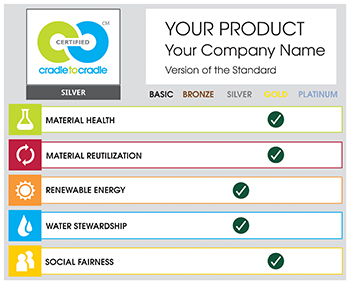Cradle to Cradle Offers New Product Registry
 SAN FRANCISCO — To increase product transparency and usability, the Cradle to Cradle Innovation Institute (CCII) has launched the Cradle to Cradle Certified Product Registry.
SAN FRANCISCO — To increase product transparency and usability, the Cradle to Cradle Innovation Institute (CCII) has launched the Cradle to Cradle Certified Product Registry.
The product registry allows designers, builders and consumers to review how Cradle to Cradle-certified products perform in the five categories of certification. The categories include: material health, material reutilization, renewable energy and carbon management, water stewardship and social fairness.
“I hope the transparency movement will keep telling folks that it’s not just knowing where you are, but knowing where you want to go next and creating that demand for healthy products,” said Bridgett Luther, president of the CCII.
Luther expects the organized database to strengthen the demand for Cradle to Cradle products. CCII is encouraging manufacturers to post their scorecards in order to display their commitment to architects and builders. The path the Cradle to Cradle certification requires dedication, Luther said, and posting manufacturer scorecards indicates a company’s continuous commitment to producing healthy products.
In the registry, products can be filtered by product categories, certification level, Cradle to Cradle versions, LEED points and MasterFormat divisions. The product registry also demystifies the Cradle to Cradle certification process and how products are scored.
“You’re lowest score on any one of the criteria is your certification level,” Luther said. “We want buyers to know that and really see where these manufacturers are coming in.”
For example, if a product scores Gold in material health and Bronze in Social Fairness, that product would be Bronze certified. Manufacturers are required to improve their products in order to gain the highest certification and healthiest products. The institute continuously monitors this progress.
“If you don’t make progress in two years you’re kicked out of the program,” Luther said. “We want to get more companies on the path but you can’t just sit there on your laurels and go around saying you’re Cradle to Cradle certified.”
Luther said she hopes the renewed transparency will spur increasing dedication to healthy products and positive change.
“Transparency is great, but only if it starts to move the needle. If we all find out we’re terrible and we don’t do anything about it, that would be the tragedy of transparency,” Luther said. “If we start to make changes, which is what Cradle to Cradle certification is because you get rewarded for it all the way up your journey, now we’re doing something.”
The new LEED v4, launched in November includes the Cradle to Cradle products program. In order to gain LEED v4 credit, a project must utilize 20 Cradle to Cradle products. More than 200 certified products are eligible for LEED v4 credit and more than 1,000 variations can be found using the new product registry. This has dramatically increased interest in Cradle to Cradle.
“We had about a 20 percent increase in our certifications last year,” Luther said. “More than half of our certifications are in the built environment because we feel that green architect want green products. They want to tell their clients that they have safer and healthier indoor products.”
The institute is also making huge advancements internationally. CCII recently announced the addition of 10 new accredited assessment bodies from Spain, Turkey, Switzerland, Germany, Brazil, the Netherlands and the United Kingdom.
“Countries look to the United States for good models,” Luther said. “My hope for the world is that everyone starts to adopt Cradle to Cradle certification for their manufacturing because then we could actually live here with 9 billion people.”
Manufacturers across the globe should inquire as to if they are designing a product that will be a positive benefit to the planet, Luther said. Though the process may be rigorous and require dedication, Cradle to Cradle certification creates a safer and healthier built environment for occupants.
“Cradle to Cradle is a path, but it’s an amazing path,” Luther said.
